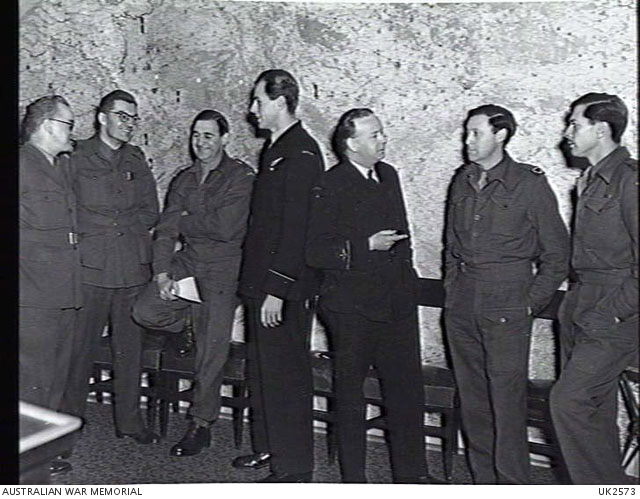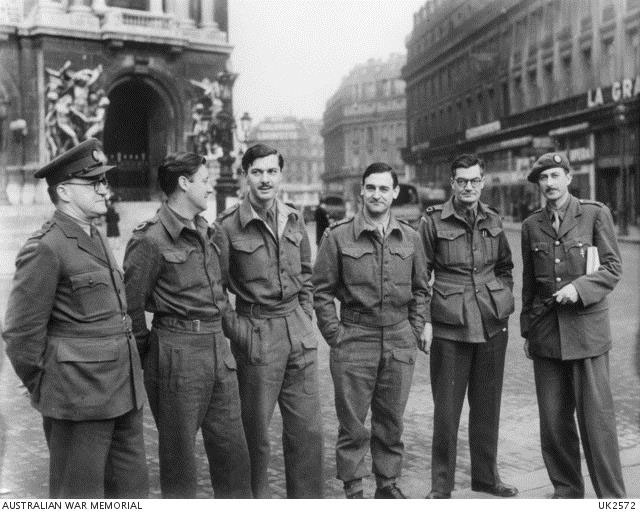Born and educated in Melbourne, Godfrey Blunden was a journalist working for the Sydney Daily Telegraph when in 1940, at the age of 34, he was sent to Europe to cover the war for Australian Consolidated Press.
Blunden arrived in time to cover the Battle of Britain and his despatches were published in the Sydney Daily Telegraph and syndicated in Britain and the US.
After the German invasion of Russia, obedient to the moral expectations of his country (and the copy-expectations of his employer, Frank Packer) Blunden took on an assignment as a correspondent to the most active and dangerous theatre of war at that time, the Russian front.
Blunden spent several months in Russia, first in Moscow and then with the Red Army as it blunted the German advance at Stalingrad. He was almost certainly the only Australian journalist to witness and report on the battle of Stalingrad.
In October 1942 Blunden reported “Stalingrad is in flames. Having failed to shift the Russians from their positions in the stubborn street fighting and fearful of a long, drawn-out battle for the city, the Germans dropped tens of thousands of incendiary bombs causing huge fires. By night the burning city can be seen scores of miles across the steppes.”
His despatches from Russia describe both the military strategy of these appalling campaigns and the acts of cruelty and compassion he witnessed or heard about with a distinctively lucid eloquence. ‘Monstrous familiar images’ – neat rows of teenaged German soldiers lying dead in the snow, a Russian family of five, machine-gunned in their home and left lying where they fell – haunted him for the rest of his life.
Following the German Sixth Army’s surrender in February 1943 Blunden reported “The people of Stalingrad believe their ruined city will arise again from its ashes. It is now a huge graveyard of buildings, whose original shape and colour, it is difficult to distinguish. Not one inch of the original soil of the city remains undisturbed. The battlefields where a few months ago tens of thousands of men met their death, are silent, and covered with a thin layer of snow.”
In late 1943 Blunden was attached to the US Ninth Airforce. During the winter of 1943–1944 the Ninth Air Force expanded at an extraordinary rate, so that by the end of May, its complement ran to 45 flying groups operating some 5,000 aircraft. With the necessary ground support units, the total number of personnel assigned to the Ninth Air Force was more than 200,000.
Along with the Eighth Air Force, the Ninth had to defeat the German Luftwaffe in the air and on the ground to bring about complete air supremacy prior to the invasion of Normandy. Operational missions involved attacks on rail marshaling yards, railroads, airfields, industrial plants, military installations, and other enemy targets in France, Belgium, and the Netherlands. Other targets were German Atlantic Wall defenses along the English Channel coast of France. Between 1 May 1944 and the invasion on 6 June 1944, the Ninth Air Force flew approximately 35,000 sorties, attacking targets such as airfields, railroad yards, and coastal gun positions.
By early August 1944 most of the Ninth Air Force’s operational fighter and bomber groups had been transferred to bases in France. In October 1944 Blunden reported “Hitler’s effort to turn Aachen into Germany’s Stalingrad has failed. The gap in the encirclement by Allied troops has been closed, vain attempts have been made by the German garrison to break out, and counter-attacks by the German forces to the east of the town during the last 24 hours have failed to get through. These attacks were broken by intense artillery barrages and by spectacular attacks by the Ninth Air Force’s fighter-bombers which, diving below the clouds, attacked advancing German forces at zero level, causing them to flee in disorder.”
Blenden was then attached to the US Ninth Army, covering the fighting in Holland and Germany. The Ninth Army, upon its arrival in Europe on 5 September 1944 was to take part in the final reduction of the German forces holding out in the French port of Brest. After the surrender of the town fifteen days later, the Ninth Army was sent east to take its place in the line between the Third Army and the First Army.
In November 1944, the Ninth Army was shifted to the very northern flank of the 12th Army Group. It undertook operations to close the front up to the Roer River. 16 December 1944 saw the opening of the last great German offensive of the war, the Battle of the Bulge. The Ninth Army was isolated from the headquarters of the 12th Army Group, and it was thus placed (on 20 December) under the command of General Bernard Montgomery’s 21st Army Group along with the First Army, despite opposition from General Omar Bradley.
Simpson, the Ninth Army’s commanading General, reoriented his command quickly to help in the reduction of the salient that the Germans had created. Many of the Ninth Army’s units passed to the command of the First Army, which was doing the main work of reducing the German salient from the north. In the meantime, the remainder of the Ninth Army continued to hold the line along the Roer River.
On 23 December 1944 Blunden reported “With the U.S. Ninth Army there is an American soldier, in the 41st Evacuation Hospital here, who had a mortar fragment the size of a .50-calibre bullet go clean through his brain and out the other side of his head. He is still living, and has every chance of returning home a normal man. This isn’t one of the miracles of modern surgery. I am assured by 34-year-old neuro-surgcon Captain Miles Gullickson, but an almost commonplace operation to-day.”
When the First Army and the Third Army had finished reducing the German salient, the First Army returned to the command of the 12th Army Group, but the Ninth Army remained under the command of the 21st Army Group for the remainder of the Rhineland Campaign.
In late February 1945 the Ninth Army launched Operation Grenade, which was the southern prong of a pincer attack coordinated with the Canadian First Army’s Operation Veritable, with the purpose of closing the front up to the Rhine River. By 10 March 1945, the Rhine River had been reached in all sectors of the Ninth Army’s front.
It was not until after 20 March 1945 that the Ninth Army units first crossed the Rhine itself. However, after doing so, the Army quickly struck east around the north of the Ruhr. An enormous pocket soon formed containing the German Army Group B under Model. By 4 April 1945, the Ninth Army had reached the Weser and was switched back to the 12th Army Group.
In April 1945 Blunden reoported “Tanks of the USA Ninth Army are using loudspeakers to broad cast, orders to German soldiers and civilians. The leading tank of one column advancing Into Germany on Tuesday reached a road block. The tank stopped and fired six leaflet shells calling on the Germans to surrender, and the tank’s loudspeaker blared forth the order. The Germans rolled the road blocks and made way, and the column rolled on. A common sight In occupied Germany is to see open-mouthed Germans reading proclamations pasted on the town walls by Allied Military Government officials. The posters begin: “We come as conquerors, but not as oppressors.”
The end of the war in Europe was now clearly in sight, and as part of the Ninth Army, along with the newly arrived Fifteenth Army, reduced the enormous Ruhr Pocket, other elements reached the Elbe River on 12 April 1945. On 2 May 1945 saw the whole of the Ninth Army’s front reach the agreed demarcation point with the Russians, and the advance ceased.
A week later Blunden reported “With the U.S. Ninth Army in Germany – May Day celebrations by the Bed Army in Germany gave Allied correspondents their first oportunity of going some distance behind the Russian front line. In recent link-ups, correspondents have not gone beyond advanced patrols, and, so far as I am aware, no Moscow correspondents have yet visited any part of Russian occupied Germany. What we saw, as we drove 30 or 40 miles in Red Army lines to attend a May Day ceremony, was not vastly different from what one sees in American-occupied Germany.”
After the war, Blunden continued to work as a journalist and authored several novels. He met Maria Rothenberg-Craipeau in Paris a month after the liberation of the city and after the war they both left for the US, where they got married and lived eleven years. He worked for Time for 14 years as a reporter in New York and later as a correspondent in Paris.
Godfrey Blunden died in 1996 having never returned to Australia, but for millions of Australian readers he will be remembered as the man who chronicled for them a good deal of the war in Europe.


Contact Marcus Fielding about this article.






